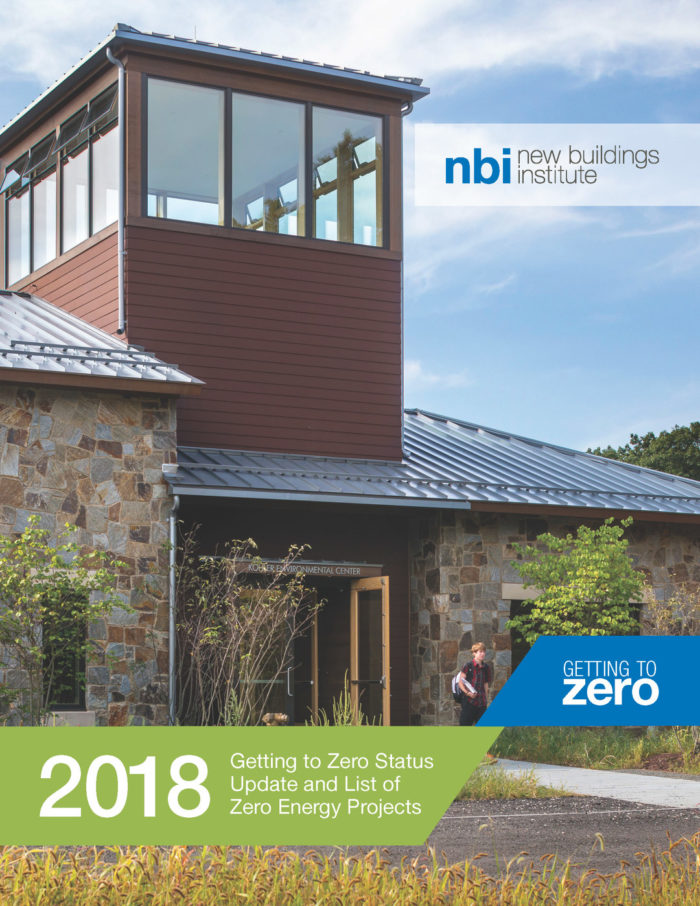
Image Credit: New Buildings Institute
Although the numbers are still very small, proven net-zero energy performance in commercial buildings is rising at a statistically rapid pace, a report from the New Buildings Institute says.
Over a 15-month period, the number of verified “ZE” projects rose from 53 to 67, an increase of 26%. A much broader category of “emerging” commercial buildings that includes projects under construction, in design and still being evaluated climbed from 279 to 415, an increase of more than 48%, the report said.
There are 6 million commercial buildings in the U.S. and Canada, so the number of projects capable of balancing energy consumption with production from renewable energy sources over the course of a year is barely a drop in the bucket. But it’s the rate of increase and a “convergence” of factors that favor zero-energy design the institute finds significant. In the first of these reports in 2012, the institute said, there were a total of 60 commercial and multifamily projects that could be listed as verified or in the works. With that number now 482, the total has increased by more than 700%.
“ZE buildings counts are still small in relation to the total market — in the single-digit percentage of total buildings and floor space,” the report says. “But a multitude of factors are accelerating ZE buildings and communities such as emerging technologies, sensors and LEDs, dramatic price drops of solar generation, energy storage, energy tracking and transparency, integrated and passive design, climate concerns, and interest in ZE codes and resilient buildings.
“This convergence, combined with other rapid advancements, foretells of a built environment that will look very different when we share our story 20 years from now.”
Projects of all types make the list
When organized by building type, education represents the largest group with 37% of the total. Office buildings and multifamily make up the next two in the rankings with 19% and 16% respectively. But developers of all stripes are showing interest in the zero-energy standard, the report says, with light manufacturing, a car dealership and a ski area making the list. Healthcare, lodging, and retail stores are categories with relatively little representation, possibly because of higher energy intensity and more complicated use patterns.
The report also makes these observations:
In addition to buildings whose developers expressly list zero-net energy as a goal, there are many others listed as “ultra-low energy buildings,” which achieve similar levels of energy performance without the addition of renewables and without having zero-energy goals. These projects are not included in the ZE tally because there are too many to list.
There are zero-energy commercial projects in 44 U.S. states and four of Canada’s 10 provinces. California, however, has seen the most growth (131%) and with 214 projects it has 44% of the total. Taken together, California and Oregon account for just under half of the total. Other regions making a particularly strong showing are the Northeast (73 projects), the Southeast (50 projects) and the Southwest (41 projects). States with no ZE projects are North Dakota, South Dakota, Oklahoma, Louisiana, Mississippi, and Alaska.
Zero-energy buildings can be found in all climate zones. But the largest grouping (226 projects) is located in Climate Zone 3, which extends across the southern tier of the U.S.
Verified projects on the list use an average of 60% less energy that comparable commercial buildings in the U.S. The median gross site Energy Use Intensity (EUI) is just under 18kBtu/square foot/year before renewables are factored in. Those projects on the emerging list have an EUI of 24kBtu/square foot/year.
Eighty-one percent of the verified buildings are 25,000 square feet or less in size, with the biggest concentration (31%) of 5,000 square feet or less. Less than 1% are bigger than 100,000 square feet. There’s better representation on the emerging side of the tally for larger buildings: 18% are larger than 100,000 square feet, and 23% are between 50,000 and 100,000 square feet.
How performance is defined
The New Building Institute uses a metric it calls the Zero Energy Performance Index, or zEPI, which favors actual energy consumption over an energy model of performance. The zEPI is calculated with the building’s EUI and is adjusted by building type and climate once a building is occupied based on measured energy use.
The report explains zEPI this way:
“ZEPI was created to address confusion caused by comparing the energy efficiency of buildings by referencing their ‘percent savings beyond code.’ Which code? What year? Given there have been at least six major commercial energy codes on the books at any given time in the United States since 2000, identifying the correct baseline can take some time.”
This new report is for commercial buildings only. Residential net-zero projects are tallied separately by the Net-Zero Energy Coalition (see the Related Articles sidebar above for an article on its latest report), although some critics doubt it is possible to count zero-energy homes accurately because of the wide distribution of renewable energy systems.
Weekly Newsletter
Get building science and energy efficiency advice, plus special offers, in your inbox.















0 Comments
Log in or create an account to post a comment.
Sign up Log in